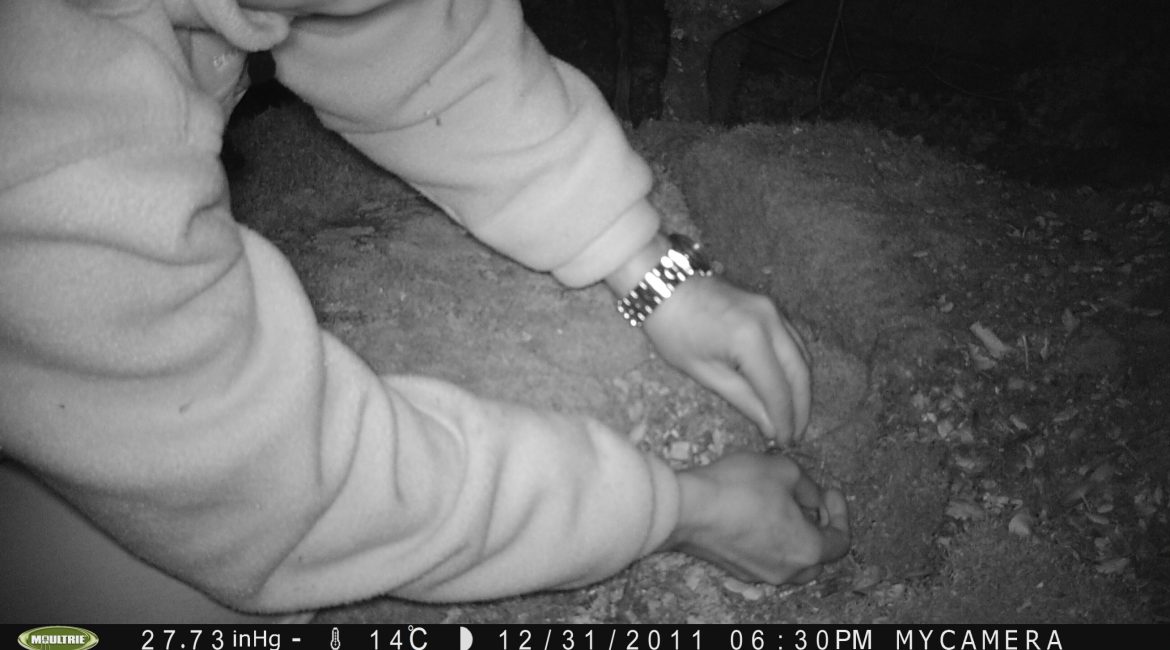Queremos comentar el interesante artículo firmado por D.G. Rocha, et al, en la revista Journal of Zoology, de la Sociedad Zoológica de Londres, 2016, con el siguiente título: “Baiting for carnivores might negatively affect capture rates of prey species in camera-trap studies”, es decir; “El uso de cebo para los carnívoros podría afectar negativamente a las tasas de captura de especies de presas, en los estudios de fototrampeo”.
En este artículo se comenta que en los estudios de identificación de carnívoros de mediano y gran tamaño mediante fototrampeo, debido a sus bajas densidades, se suelen utilizar cebos como atrayentes, para aumentar el número de registros fotográficos, que de otra manera sería escasos.
Para ello se colocaron diversas cámaras de fototrampeo en la zona central del Amazonas brasileño y se estudió el efecto de un cebo, habitual en estos estudios, como es una mezcla de sardinas frescas con huevo. El objetivo fue comprobar si los registros de los carnívoros y sus especies presa aumentaban con este atrayente, o no, y si la calidad de los registros/identificaciones de individuos aumentaba con el uso del cebo.
Pues bien, comprobaron que, aunque los registros de carnívoros aumento con el uso del cebo, no se obtuvo un incremento en el número de individuos identificados. Es decir, los animales seguían siendo los mismos registrados por las cámaras sin cebo, pero eran fotografiados en más ocasiones, por lo que no sirvió como una ventaja para la identificación individual de los carnívoros.
De igual manera se comprobó que el número de registros de especies presa disminuía claramente en las estaciones de fototrampeo en las que se utilizó cebo. Como conclusión, los autores, recomiendan considerar con mucho cuidado el uso de cebos en estudios de fototrampeo.
Esto me lleva a reflexionar sobre algo que llevo muchos años tratando en cursos, artículos y comentando con los aficionados al fototrampeo. No debemos hacer lo que hace la gente, solo porque parezca habitual, sino tener criterio propio y reflexionar antes de realizar actividades de fototrampeo.
Dependiendo del objetivo, por supuesto, podemos tener más condicionantes de diseño o no. No es lo mismo poner la cámara para ver que sale, por el gusto de observar a la fauna, que embarcarse en un estudio más profundo sobre la composición, estructura y dinámica de las poblaciones faunísticas. Por ello estos aspectos pueden ser únicamente cuestiones éticas o también metodológicas.
Es cierto que con cebo es más rápido que algunas especies aparezcan delante de la cámara, los primeros días, pero a la larga también comprobaremos como el posible efecto atrayente disminuye y los animales comienzan a desfilar por delante de la cámara sin problemas. ¿Entonces porqué ponemos cebo? ¿Es quizás lo que nos dicen que hay que hacer?
En mi opinión el fototrampeo es una forma de poder ver lo que ocurre en la naturaleza sin estar allí. Por ello no deberíamos intentar ver una naturaleza condicionada, transformada, adulterada, sino ver lo que ocurre de manera natural, sin intervenciones.
En definitiva, a no ser que sea imprescindible, por razones justificadas, creo que deberíamos dejar de poner cebos delante de las cámaras, porque afectan a los resultados, porque son perjudiciales para los animales, transforman su comportamiento y sobre todo, porque deberíamos ser respetuosos con lo que amamos.

